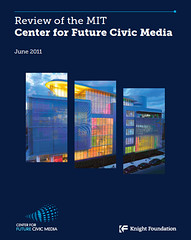The Center for Future Civic Media (C4) was established in May 2007 as a partnership of three principal investigators – Professors Henry Jenkins, Chris Csikszentmihályi, and Mitch Resnick – from the Media Lab and the Comparative Media Studies department at MIT. C4 has been supported by a four-year, $5 million grant from the John S. and James L. Knight Foundation. The accomplishments of C4 include:
1. developing dynamic, promising new methodologies in the emerging field of civic media;
2. creating a teaching program in this new field that is attracting top-flight graduate students to MIT;
3. producing a series of projects, many of which are growing in influence, that are rooted in meeting the information needs of specific communities, as far from MIT as Juarez, Mexico and as close by as Boston, Massachusetts; and,
4. convening the field of civic media, primarily through an annual conference at MIT as well as weekly events that generated tens of thousands of views online.
Since its founding, C4 has led the effort to define and shape a new field in civic media. The Center is establishing a reputation as a go-to place for the use of a community-oriented methodology to technology design, development, and deployment. The most recent professorial hire in the Comparative Media Studies is Sacha Costanza-Cook, a faculty member in the civic media field. The Media Lab appears committed to developing additional teaching and research capacity in this area as well. The Center’s staff and students have initiated a series of projects with great promise, though most are at an early stage of deployment. The Center has established a positive learning environment within MIT at large, and the Media Lab in particular, where students can develop their interest in a publicspirited, critical approach to using technology to directly affect communities
The C4 experience in its first four years or so holds important lessons for those interested in 1) substantive questions related to media innovation; 2) teaching and learning in the atelier style as it relates to the study of media and innovation; and 3) the process of incubating innovation in the context of universities. The approach that C4 has taken is novel in many respects. They have sought to develop a new field of civic media. They brought together faculty, staff, and students from two university departments with strong identities and distinct disciplinary approaches into a single, interdisciplinary effort. They set out explicitly to listen to communities before building solutions. And they have designed new ways for students to learn, to innovate, and to contribute to society at large.
It is not the case that everything that C4 has undertaken has succeeded. Many projects remain unfinished; others should surely be abandoned, as is common in incubators and as is the practice at C4; and new efforts will be folded in or developed in the years to come. And it would be hard for many other kinds of institutions to seek to mimic C4’s exact approach. But some broad and universal lessons emerge from C4’s early years that are worth sharing in public, talking about, and building upon in ways that are both direct and indirect. The innovations, in substance and in process, underway at C4 in its short history offer much for all of us who care about this field to consider.

